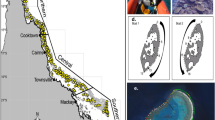Abstract
This study documents the pattern and rate of reef growth during the late Holocene as revealed by unique geological conditions at the subsiding NW Gulf of Aqaba. We discovered that the modern fringing reef near the city Elat grows on top of a fossil submerged mid-Holocene reef platform. Four coral cores from the fossil platform were dated using the radiocarbon and U-Th methods. The fossil corals range from 5.6±0.1 to 2.4±0.03 ka, constraining the initiation of the modern reef to 2,400 years ago at most. We documented the detailed morphology of the reef using aerial photographs and scuba diving. The survey shows that at its northern end, growth of the 2-km-long reef is inhibited by an active alluvial fan, and it is composed of isolated knolls that are just approaching the sea surface. Towards the south, the knolls are progressively larger and closer together, until they form a continuous reef platform. Along this north-to-south trend we follow the evolution of reef morphology, changes in coral distribution, and the development of a lagoon separated from the open sea. Based on these observations, we suggest a four-stage reef growth model: (a) the reef initiates as coral colonies, forms knolls, and begins to grow upward, limited by the sea surface. (b) Upon reaching the surface, the knolls spread laterally, preferentially parallel to the dominant wave direction assuming an elongated morphology. (c) Continued growth results in adjacent knolls eventually coalescing to form a continuous jagged reef. We interpret the spurs-and-grooves morphology that can be traced across the reef at Elat as remnants of the original trends of knolls. (d) While reef expansion continues, the original knoll trends may be obscured as a massive reef front takes shape. Considering reef growth rates and observations from the modern reef at Elat, this evolution scheme predicts an age range of 103 years for corals on the reef platform. The range and distribution of radiometric ages we obtained from the fossil reef platform underlying the living Elat reef confirm this hypothesis.





Similar content being viewed by others
References
Aronson RB, Precht WF (1995) Landscape patterns of reef coral diversity—a test of the intermediate disturbance hypothesis. J Exp Mar Biol Ecol 192:1–14
Bard E, Hamelin B, Fairbanks RG (1990) U-Th ages obtained by mass spectrometry in corals from Barbados: sea level during the past 130,000 years. Nature 346:456–458
Bar-Matthews M, Wasserburg GJ, Chen JH (1993) Diagenesis of fossil coral skeletons: correlation between trace elements, textures, and 234U/238U. Geochim Cosmochim Acta 57:257–276
Barnes DJ, Lazar B (1993) Metabolic performance of a shallow reef patch near Eilat on the Red-Sea. J Exp Mar Biol Ecol 174:1–13
Blanchon P, Jones B (1995) Marine-planation terraces on the shelf around Grand Cayman—a result of stepped Holocene sea level rise. J Coastal Res 11:1–33
Bloom AL, Broecker WS, Chappell JMA, Matthews RK, Mesolella KJ (1974) Quaternary sea level fluctuations on a tectonic coast: new 230Th/234U dates from the Huon Peninsula, New Guinea. Quaternary Res 4:185–205
Braithwaite CJR, Montaggioni LF, Camoin GF, Dalmasso H, Dullo WC, Mangini A (2000) Origins and development of Holocene coral reefs: a revisited model based on reef boreholes in the Seychelles, Indian Ocean. Int J Earth Sci 89:431–445
Burke CD, McHenry TM, Bischoff WD, Mazzullo SJ (1998) Coral diversity and mode of growth of lateral expansion patch reefs at Mexico Rocks, northern Belize shelf, Central America. Carbonate Evaporite 13:32–42
Burr GS, Edwards RL, Donahue DJ, Druffel ERM, Taylor FW (1992) Mass spectrometric 14C and U-Th measurements in coral. Radiocarbon 34: 611–618
Bythell JC, Hillis-Starr ZM, Rogers CS (2000) Local variability but landscape stability in coral reef communities following repeated hurricane impacts. Mar Ecol-Prog Ser 204:93–100
Cabioch G, Correge T, Turpin L, Castellaro C, Recy J (1999) Development patterns of fringing and barrier reefs in New Caledonia (southwest Pacific). Oceanologica Acta 22:567–578
Camoin GF, Colonna M, Montaggioni LF, Casanova J, Faure G, Thomassin BA (1997) Holocene sea level changes and reef development in the southwestern Indian Ocean. Coral Reefs 16:247–259
Chappell J (1974) Geology of coral terraces, Huon Peninsula, New Guinea: a study of Quaternary tectonic movements and sea-level changes. Geol Soc Am Bull 85:553–570
Chappell J, Ota Y, Berryman K (1996) Late Quaternary coseismic uplift history of Huon Peninsula, Papua New Guinea. Quaternary Sci Rev 15:7–22
Chen JH, Curran HA, White B, Wasserburg GJ (1991) Precise chronology of the last interglacial period: 234U-230Th data from fossil coral reefs in the Bahamas. Geol Soc Am Bull 103:82–97
Cortés J, Macintyre IG, Glynn PW (1994) Holocene growth of an eastern Pacific fringing reef, Punta Isoltes, Costa Rica. Coral Reefs 13: 65–73
Darwin CR (1842) The structure and distribution of coral reefs. Smith, Elder and Co., London, p 214
Davies PJ, Marshall JF (1980) A model of epicontinental reef growth. Nature 287:37–38
Edmunds PJ (2000) Patterns in the distribution of juvenile corals and coral reef community structure in St. John, US Virgin Islands. Mar Ecol-Prog Ser 202:113–124
Edwards RL, Chen JH, Wasserburg GJ (1987) 238U-234U-230Th-232Th systematics and the precise measurement of time over the past 500,000 years. Earth Planet Sci Lett 81:175–192
Eisenhauer A, Wasserburg GJ, Chen JH, Bonani G, Collins LB, Zhu ZR, Wyrwoll KH (1993) Holocene sea-level determination relative to the Australian continent: U/Th (TIMS) and 14C (AMS) dating of coral cores from the Abrolhos Islands. Earth Planet Sci Lett 114:529–547
Enmar R, Stein M, Bar-Matthews M, Sass E, Katz A, Lazar B (2000) Diagenesis in live corals from the Gulf of Aqaba. I. The effect on paleo-oceanography tracers. Geochim Cosmochim Acta 64:3123–3132
Fleming K, Johnston P, Zwartz D, Yokoyama Y, Lambeck K, Chappell J (1998) Refining the eustatic sea-level curve since the Last Glacial Maximum using far- and intermediate-field sites. Earth Planet Sci Lett 163:327–342
Goreau TF (1959) The ecology of Jamaican coral reefs I. Species composition and zonation. Ecology 40:67–90
Goreau TF, Goreau NI (1973) The ecology of Jamaican coral reefs. II. Geomorphology, zonation, and sedimentary phases. J Mar Sci 23:399–464
Grigg RW (1998) Holocene coral reef accretion in Hawaii: a function of wave exposure and sea level history. Coral Reefs 17:263–272
Hopley D, Slocombe AM, Muir F, Grant C (1983) Nearshore fringing reefs in North Queensland. Coral Reefs 1:151–160
Kan H, Hori N, Nakashima Y, Ichikawa K (1995) The evolution of narrow reef flats at high-latitude in the Ryukyu Islands. Coral Reefs 14:123–130
Kan H, Hori N, Ichikawa K (1997) Formation of a coral reef-front spur. Coral Reefs 16:3–4
Kennedy DM, Woodroffe CD (2002) Fringing reef growth and morphology: a review. Earth-Sci Rev 57:255–277
Lirman D, Glynn PW, Baker AC, Morales GEL (2001) Combined effects of three sequential storms on the Huatulco coral reef tract, Mexico. Bull Mar Sci 69:267–278
Loya Y, Slobodkin LB (1971) The coral reefs of Eilat (Gulf of Eilat, Red Sea). Symp Zool Soc Lond 28:117–139
Montaggioni L (2000) Postglacial reef growth. Comptes Rendus De L Academie Des Sciences Serie II Fascicule A-Sciences De La Terre Et Des Planetes 331:319–330
Perry CT (1998) Macroborers within coral framework at Discovery Bay, north Jamaica: species distribution and abundance, and effects on coral preservation. Coral Reefs 17:277–287
Perry CT (1999) Reef framework preservation in four contrasting modern reef environments, Discovery Bay, Jamaica. J Coastal Res 15:796–812
Pirazzoli PA (1991) World atlas of Holocene sea-level changes. Elsevier, Amsterdam, p 299
Ramsey CB (1995) Radiocarbon calibration and analysis of stratigraphy: the OxCal program. Radiocarbon 37:425–430
Ramsey CB (2001) Development of the radiocarbon program OxCal. Radiocarbon 43:381–389
Shaked Y, Marco S, Lazar B, Stein M, Cohen C, Sass E, Agnon A (2002) Late Holocene shorelines at the Gulf of Elat: migrating shorelines despite tectonic and sea level stability. EGS Stephan Mueller special publication series 2, pp 105–111
Shaked Y, Agnon A, Lazar B, Marco S, Avner U, Stein M (2004) Large earthquakes kill coral reefs at the north-west Gulf of Aqaba. Terra Nova 16:133–138
Shinn EA (1988) The geology of the Florida Keys. Oceanus 31:46–53
Shinn EA, Hudson JH, Robbin DM, Lidz B (1981) Spurs and grooves revisited: construction versus erosion Looe Key reef, Florida. In: Proceedings of the 4th International Coral Reef Symposium, vol 1. Manila, pp 475–483
Sneh A, Friedman GM (1980) Spur-and-groove patterns on the reefs of the northern gulfs of the Red Sea. J Sediment Petrol 50:981–986
Stein M, Wasserburg GJ, Aharon P, Chen JH, Zhu ZR, Bloom A, Chappell J (1993) TIMS U-series dating and stable isotopes of the last interglacial event in Papua New Guinea. Geochim Cosmochim Acta 57:2541–2554
Stuiver M, Polach HA (1977) Discussion; reporting of c-14 data. Radiocarbon 19:355–363
Stuiver M, Reimer PJ, Bard E, Beck JW, Burr GS, Hughen KA, Kromer B, McCormac G, Van-Der-Plicht J, Spurk M (1998) INTCAL98 radiocarbon age calibration, 24,000-0 cal BP. Radiocarbon 40:1041–1083
Tudhope AW, Buddemeier RW, Chilcott CP, Berryman KR, Fautin DG, Jebb M, Lipps JH, Pearce RG, Scoffin TP, Shimmield GB (2000) Alternating seismic uplift and subsidence in the late Holocene at Madang, Papua New Guinea: evidence from raised reefs. J Geophys Res 105:13797–13807
Woodroffe CD, Kennedy DM, Hopley D, Rasmussen CE, Smithers SG (2000) Holocene reef growth in Torres Strait. Mar Geol 170:331–346
Yamano H, Kayanne H, Yonekura N (2001) Anatomy of a modern coral reef flat: a recorder of storms and uplift in the late Holocene. J Sediment Res 71:295–304
Zachariasen J, Seih K, Taylor FW, Edwards RL, Hantoro WS (1999) Submergence and uplift associated with the giant 1833 Sumatran subduction earthquake: evidence from coral microatolls. J Geophys Res 104:895–919
Acknowledgements
We wish to acknowledge the help and support provided by the Interuniversity Institute at Elat. We also thank D. Zakai, and the Israel Nature and Parks Authority for supporting the work at the Elat Nature Reserve beach. E. Boaretto of the Weizmann Institute of Science undertook radiocarbon dating. This research was funded by the Israel Ministry of National Infrastructures, and the Shapira Fund, Hebrew University. Careful reviews by C. Braithwaite and C. Perry greatly improved this manuscript.
Author information
Authors and Affiliations
Corresponding author
Additional information
Communicated by Geological Editor P.K. Swart
Rights and permissions
About this article
Cite this article
Shaked, Y., Lazar, B., Marco, S. et al. Evolution of fringing reefs: space and time constraints from the Gulf of Aqaba. Coral Reefs 24, 165–172 (2005). https://doi.org/10.1007/s00338-004-0454-2
Received:
Accepted:
Published:
Issue Date:
DOI: https://doi.org/10.1007/s00338-004-0454-2




